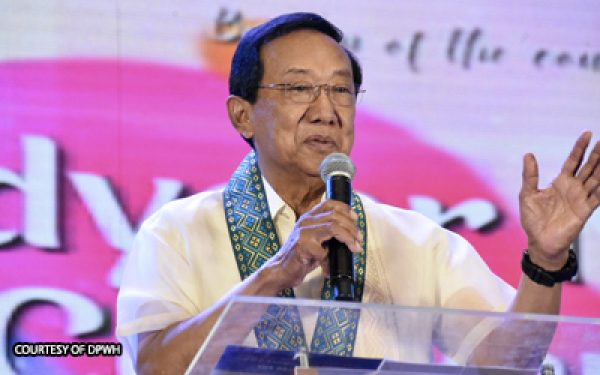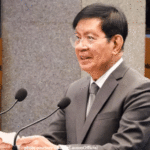The Department of Public Works and Highways (DPWH) admitted that there are allegedly «ghost» or fake flood control projects, a matter that the agency is now investigating.
During the hearing of the Senate Blue Ribbon Committee this Tuesday, August 19, Senate President Pro Tempore Jinggoy Estrada asked DPWH Secretary Manuel Bonoan if there was truth to the report of a ghost project in the 1st engineering district of Bulacan.
«Yes, your honor,» Bonoan replied. «This is the information that we have received.»
According to the secretary, he only learned of this anomaly recently and it is currently being verified.
Estrada revealed that these ghost projects are in Calumpit, Malolos, and Hagonoy, Bulacan. Bonoan confirmed that the contractor for these projects is Wawao Builders Corporation, which has a total budget of P5.9 billion in Bulacan from 2022 to 2025.
According to Bonoan, the total value of the projects acquired by the company nationwide is P9 billion. In Bulacan, it secured 85 projects worth P5.971 billion.
The secretary said they are investigating this and once proven to be ghost projects, they will file the appropriate charges.
«We will file all the necessary charges, Your Honor and ghost projects are actually, as I said, anybody involved in the implementation of those projects should be answerable,» the secretary emphasized.
Based on the list of President Ferdinand «Bongbong» Marcos Jr., Wawao Builders is among the 15 largest contractors that secured nearly P100 billion nationwide from July 2022 to May 2025.
The company, led by Mark Allan Villamor Arevalo, has not yet responded to the Senate’s invitation to attend the investigation.
Because of this, the committee issued subpoenas to the eight contractors who did not attend the hearing this Tuesday.
Of the 15 contractors invited, only seven attended, with some company owners appearing personally and others sending representatives.
Those to be subpoenaed are Cezarah Dizcaya-President, Alpha and Omega Gen. Contractor 8 Development Corporation; Ma. Roma Angeline Romando-Owner/Manager St. Timothy Construction Corporation; Eumir Villanueva- President, Topnotch Catalyst Builders Inc.; and Aderma Angelie Alcazar-President/CEO, Sunwest, Inc.
The others are Edgar Acosta-President, Hl-Tone Construction & Development Corp.; Romeo Miranda- President AMO, Royal Crown Monarch Construction & Supplies Corp.; Mark Allan Arevalo-General Manager, Wawao Builders; and Luisito Tiqui- President, L.R. Tiqui Builders, Inc.
Secretary Bonoan was reprimanded during the hearing for his lack of coordination with the River Basin Control Office, a government office mandated to consolidate flood control projects in the country.
During the hearing, Senator Rodante Marcoleta, chairman of the committee, stated that the River Basin Control Office was not included in the overall equation when it comes to the government’s development of flood control projects.
«Why, in the entire equation, in the entire continuum of this problem, why does this office not even surface? It turns out they have the mandate. We only found out now that if you are not coordinating, you are not the regulator,» Marcoleta said.
Department of Public Works and Highways
The Department of Public Works and Highways (DPWH) is the executive department of the Philippine government responsible for the planning, design, construction, and maintenance of national infrastructure, particularly highways, flood control, and public works. It was formally established in 1868 during the Spanish colonial period as the *Inspección General de Obras Públicas* and has evolved through various reorganizations, including a major one in 1987. Its primary mission is to provide and manage quality infrastructure facilities and services that are instrumental in national development.
Senate Blue Ribbon Committee
The Senate Blue Ribbon Committee is a permanent investigative body of the Philippine Senate. Its primary purpose is to investigate alleged instances of corruption, inefficiency, and waste of government funds and resources by public officials and employees. It was formally established in 1992 to strengthen the Senate’s oversight functions.
Bulacan
Bulcalan is a province in the Philippines, historically renowned as a major center of the 1896 Philippine Revolution against Spanish colonial rule. It is home to significant sites like the Barasoain Church, where the First Philippine Republic was established. Today, it is a key economic and agricultural region known for its heritage, cuisine, and crafts.
Calumpit
Calumpit is a first-class municipality in the province of Bulacan, Philippines, known historically as one of the oldest towns in the region. It was established by the Augustinian friars in 1575 and served as a significant religious and agricultural center during the Spanish colonial era. The town is also notable for its role in the Philippine Revolution and for the historic Sulipan Apalit Bridge.
Malolos
Malolos is a historic city in the Philippines, best known as the site where the First Philippine Republic was established. It served as the capital of the revolutionary government in 1898, and the Barasoain Church was the venue for the drafting of the Malolos Constitution. This event marked the first attempt at a democratic government in Asia.
Hagonoy
Hagonoy is a coastal municipality in the Philippines’ Bulacan province, historically known as a significant fishing and agricultural center. Its name is derived from the Tagalog word «hagunoy,» a local plant, and it is renowned for its vibrant Catholic festivals, particularly the feast of its patron saint, Saint Anne.
Wawao Builders Corporation
I am unable to provide a summary for «Wawao Builders Corporation» as it does not appear to be a recognized historical place or cultural site. It seems to be the name of a modern commercial business, likely a construction or development company, for which no significant public history or cultural importance is documented.
River Basin Control Office
The River Basin Control Office is a modern administrative entity responsible for managing water resources, flood control, and environmental conservation within a specific river system. It was established in the 20th century as part of governmental efforts to implement scientific water management and mitigate the impacts of seasonal flooding. Its history is tied to the development of national infrastructure and a growing understanding of hydrological engineering.




